Hazelnut coffee macarons are such tasty macarons for coffee lovers. The warm and nutty flavor and perfect chewy macaron texture have just the right balance of sweetness and make an expensive gourmet-tasting treat.
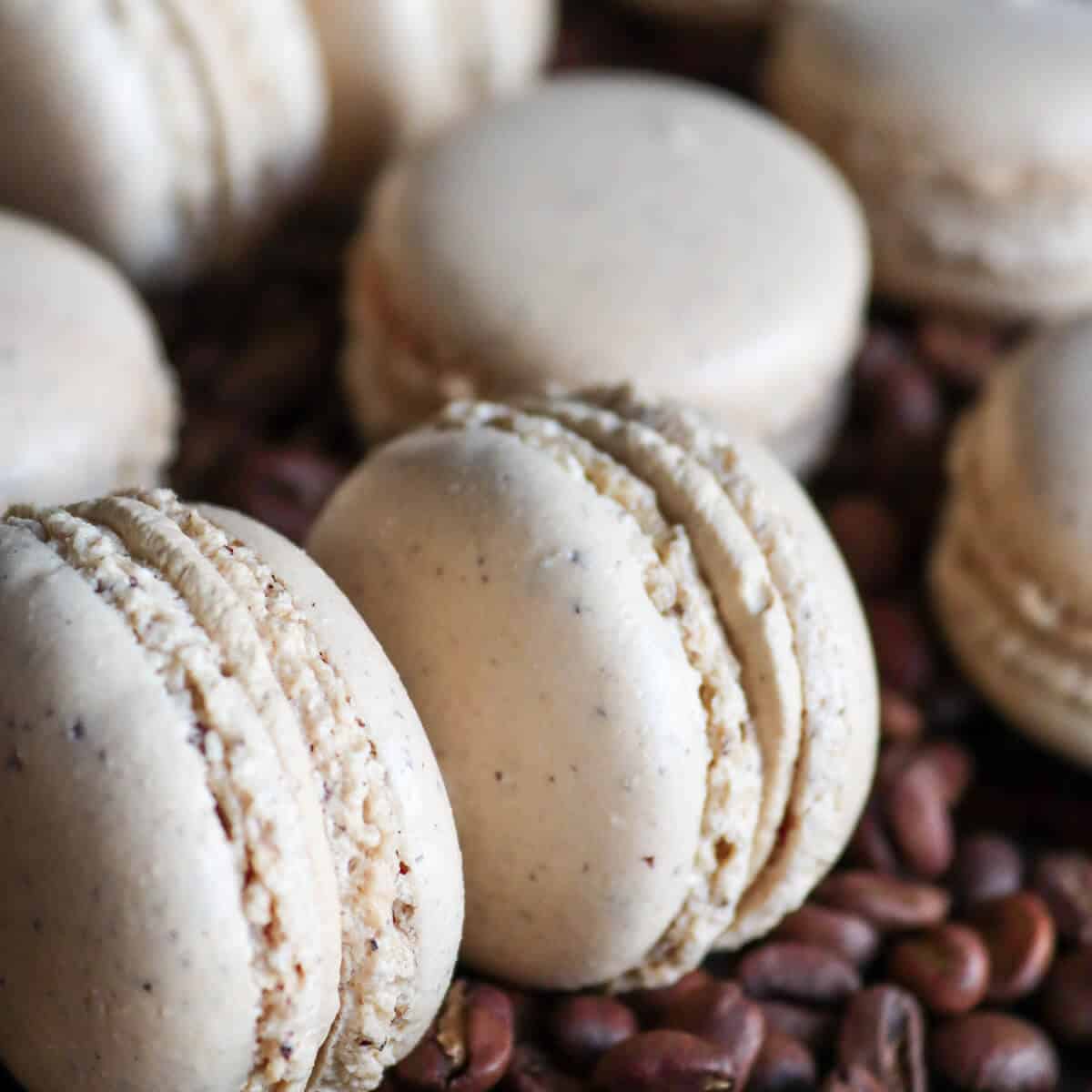
Why you should make hazelnut macarons
Hazlenut flour macarons have a different taste to almond macarons, and the hazelnut flavor from the hazelnut flour in this macaron recipe is very pronounced and really brings out the coffee macaron filling. Hazelnut coffee macarons work at any time of year, and I enjoy them especially after dinner served as a petit four.
I make homemade macarons with Italian meringue as opposed to the French method, as it gives them more stability and makes them harder to overmix. If this is your first time making macarons, check out my full step by step guide to making Italian macarons with Italian meringue first.
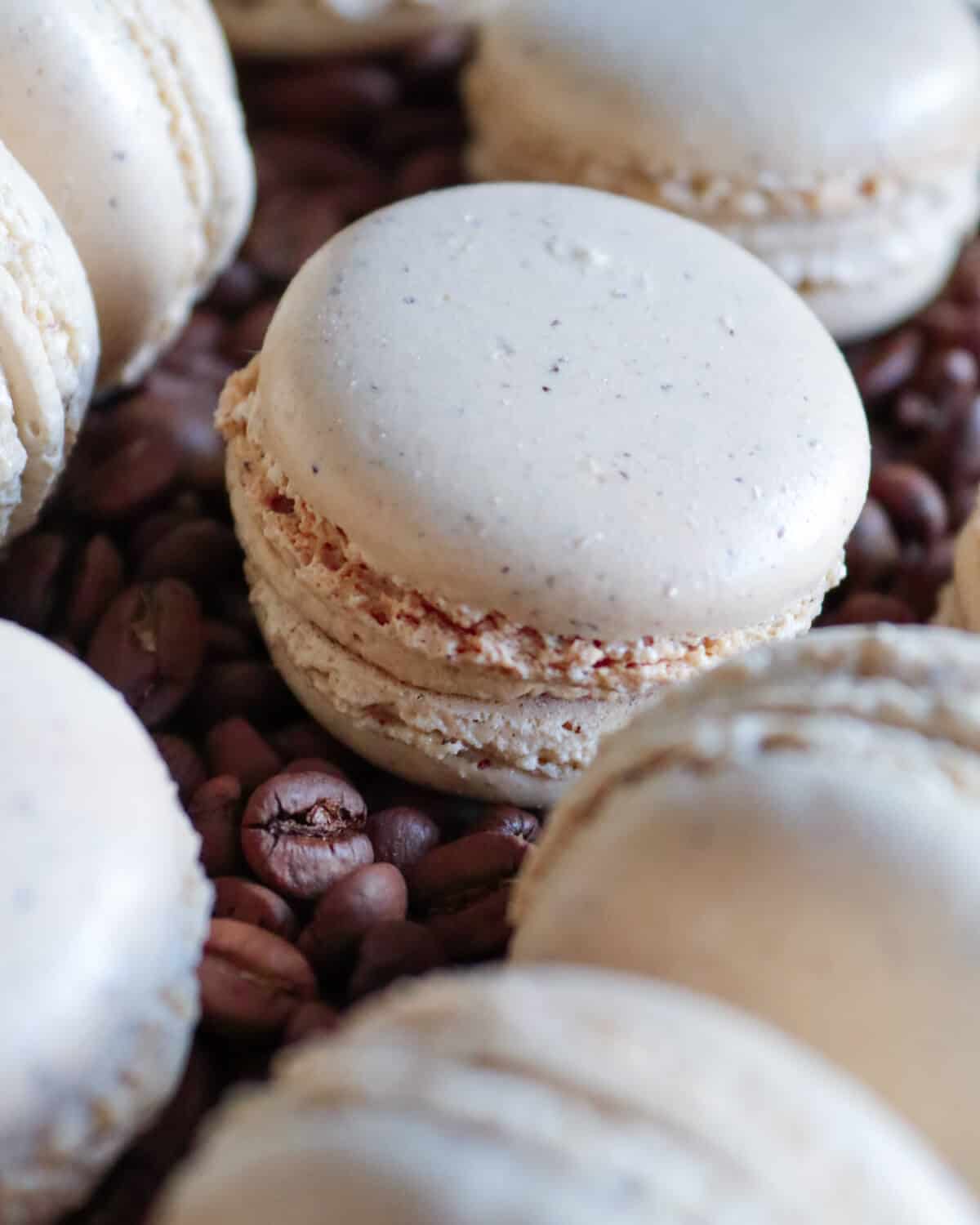
Jump to:
Ingredients
Here are the ingredients you will need for these hazelnut coffee macarons.
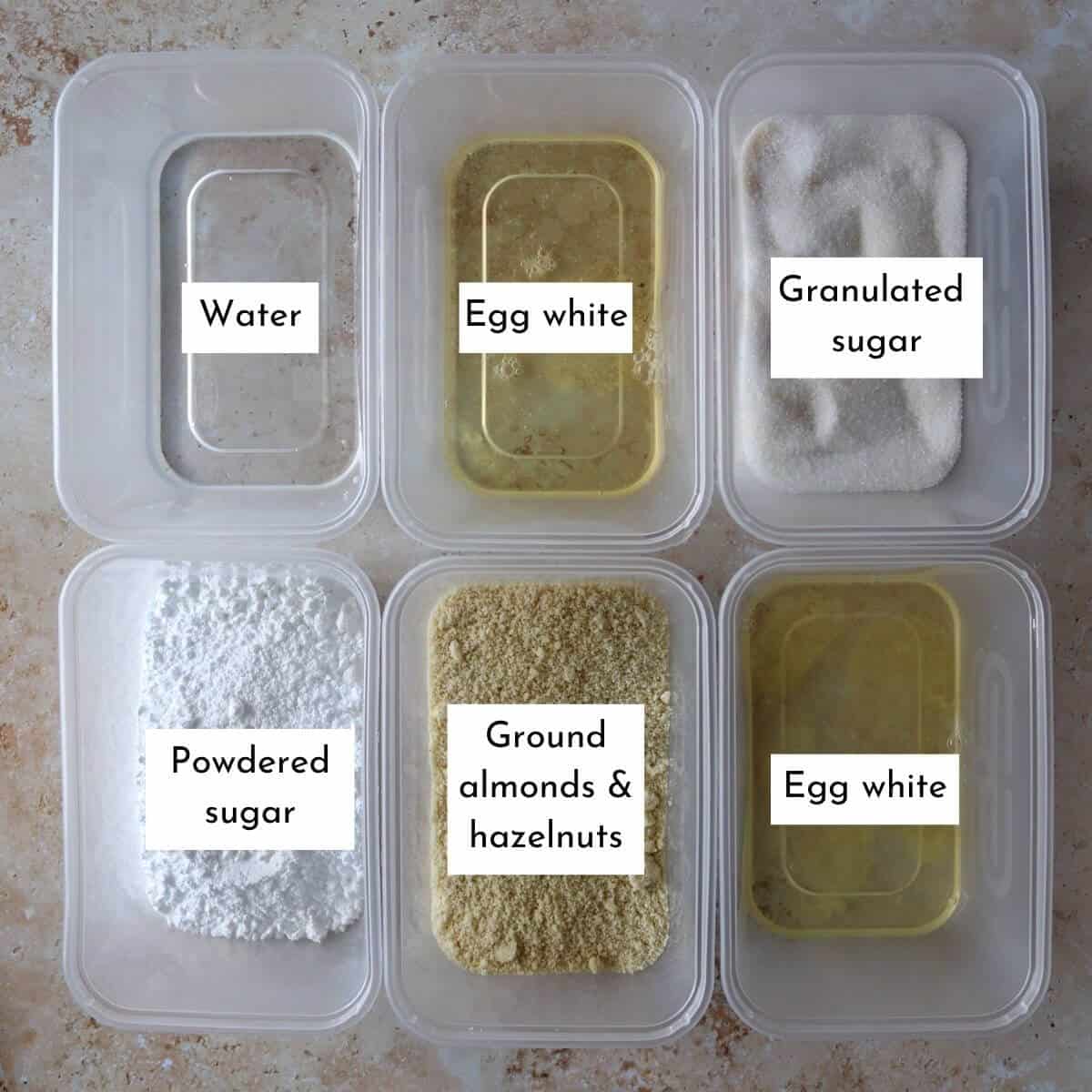
Hazelnut macaron shells
- Ground hazelnuts/hazelnut flour: there is much discussion as to whether or not ground nuts, nut flour, and nut meal are the same. The main difference is how finely ground they are. For macarons, we want as finely ground nuts as possible, which usually means nut flour is best. But we blend it again with powdered sugar anyway, so if you can only find a nut meal, then this is fine.
- Ground almonds/almond flour: We still need to use almond flour in hazelnut macarons to get the right balance of fat.
- Powdered sugar/icing sugar: Powdered sugar (or confectioners' sugar) is used in the nut paste we make that is then mixed with the Italian meringue.
- Instant coffee powder: A small pinch of coffee powder in the nutty meringue cookie shells help give even more coffee flavor.
- Egg whites: Use room-temperature egg whites in macarons or any baking recipe. Take care when separating the eggs so that no yolk gets into the whites, or you will end up with a failed meringue.
- Light brown fine granulated sugar/golden caster sugar: I like to use fine golden sugar in these hazelnut coffee macarons as the added molasses content gives a slight hint of caramel taste. Alternatively, use fine white sugar (or white caster sugar).
- Water: When making an Italian meringue, we dissolve sugar into the water before bringing it to a boil and making the hot sugar syrup. It helps the sugar to melt more evenly.
Coffee cream macaron filling
- Cinnamon: A touch of warm cinnamon spice adds extra depth to the coffee macaron filling.
- Double cream/heavy cream: The thick coffee cream filling is so delicious. Use high-quality cream with good fat content.
- Instant coffee powder: Use instant espresso powder for the most concentrated coffee taste.
See the recipe card for full quantities and step-by-step directions.
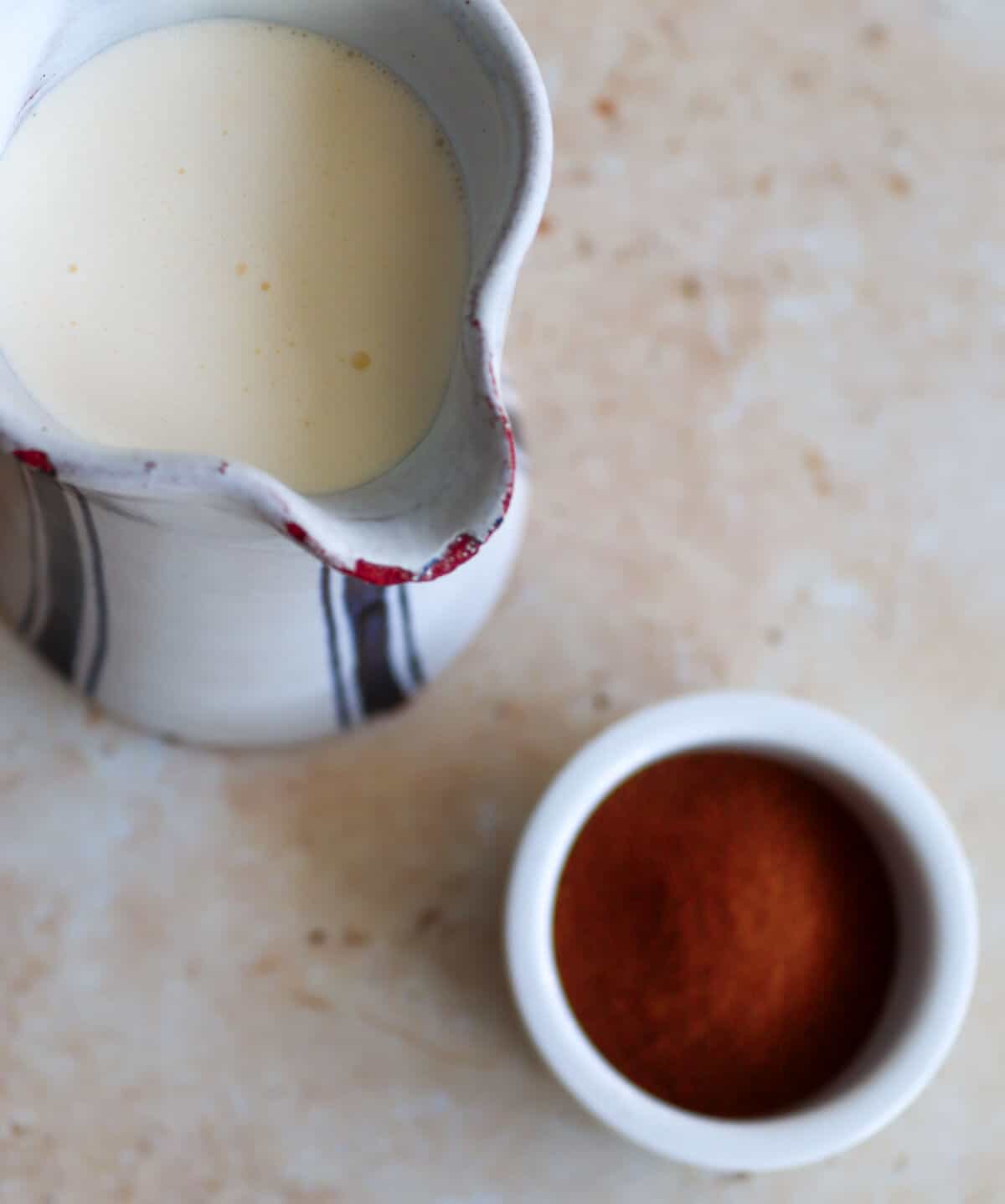
Instructions
Preheat the oven to 145 degrees Celsius / 295 Fahrenheit. Line baking sheets or cookie sheets with parchment paper.
Prepare and weigh out the dry ingredients and wet ingredients, separating the room temperature egg whites from the egg yolks. Take care not to get any egg yolk into the white.
Wipe the bowls, saucepan, and whisk attachment of a stand mixer or handheld electric whisk with white wine vinegar to remove residual fat.
Making macarons
Make the nut paste by sieving the ground almond and hazelnut and icing sugar to remove any lumps. Then blend the sugar and nut mixture together in a food processor until they are a very fine powder consistency and thoroughly combined but do not overmix, or the nut flours can release too much of their oils.
Stir in a teaspoon of coffee powder and put the mixture into a large mixing bowl.
Mix the first lot of egg white with the ground nuts/powdered sugar mixture until it is fully incorporated into a paste.
Prepare the Italian meringue. Place the water and granulated sugar into a saucepan over medium heat. Stir to dissolve the sugar for 2-3 minutes. Turn up the heat, then stop stirring, and place the sugar thermometer into the mixture.
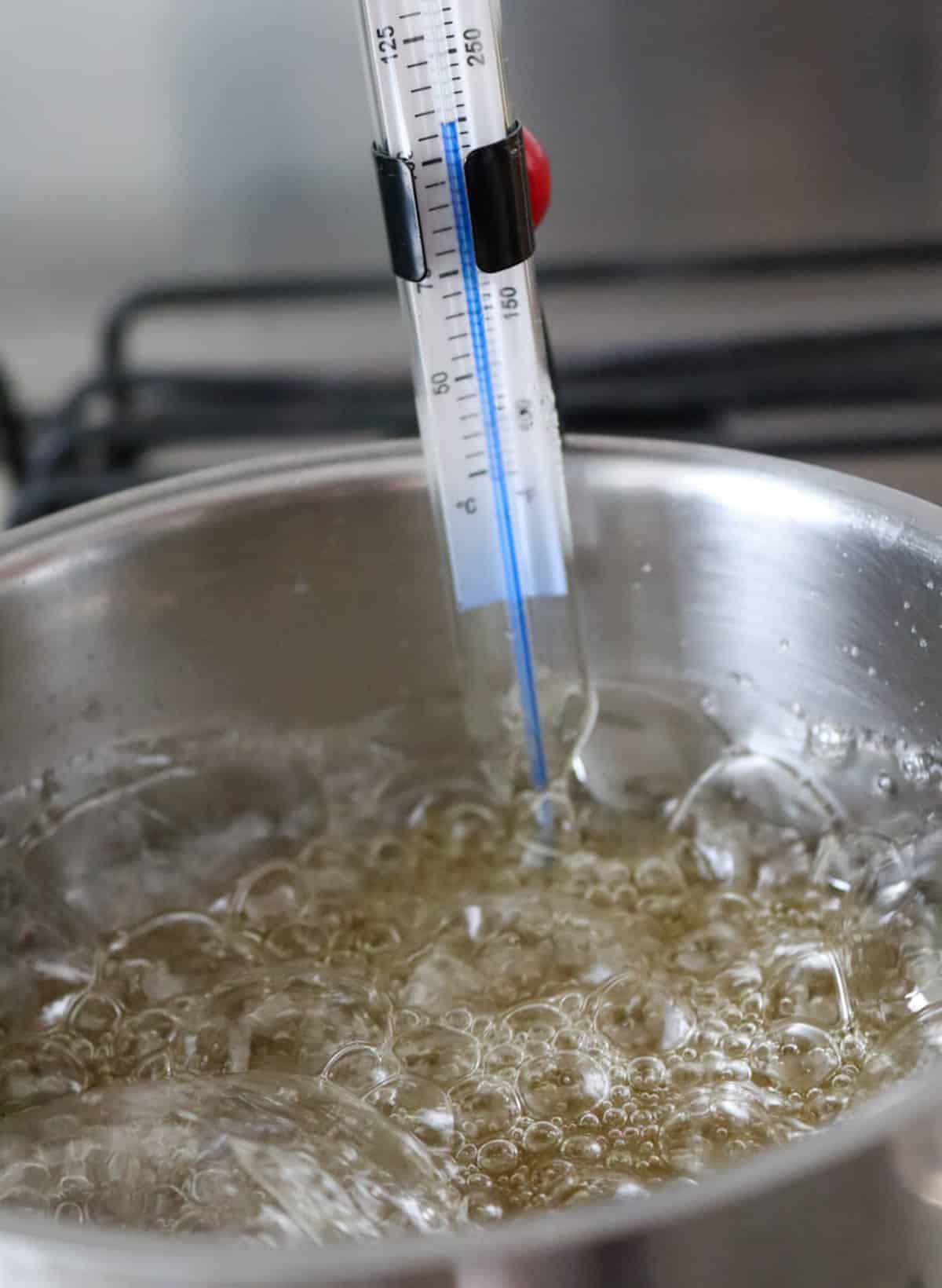
Once the temperature reaches 115 degrees Celsius/240 degrees, whisk the other egg whites in a separate large bowl at medium speed until they form soft peaks. You can use a food processor with the whisk attachment or an electric hand whisk. Then very slowly, start to pour the sugar syrup down the side of the bowl into the whisked eggs whilst continuing to whisk.
The Italian meringue will turn a smooth, glossy, and opaque white, and stiff peaks will form. Continue to whisk once all of the sugar syrup has been added to bring down the heat until you can touch the sides of the bowl and it feels warm but not hot.
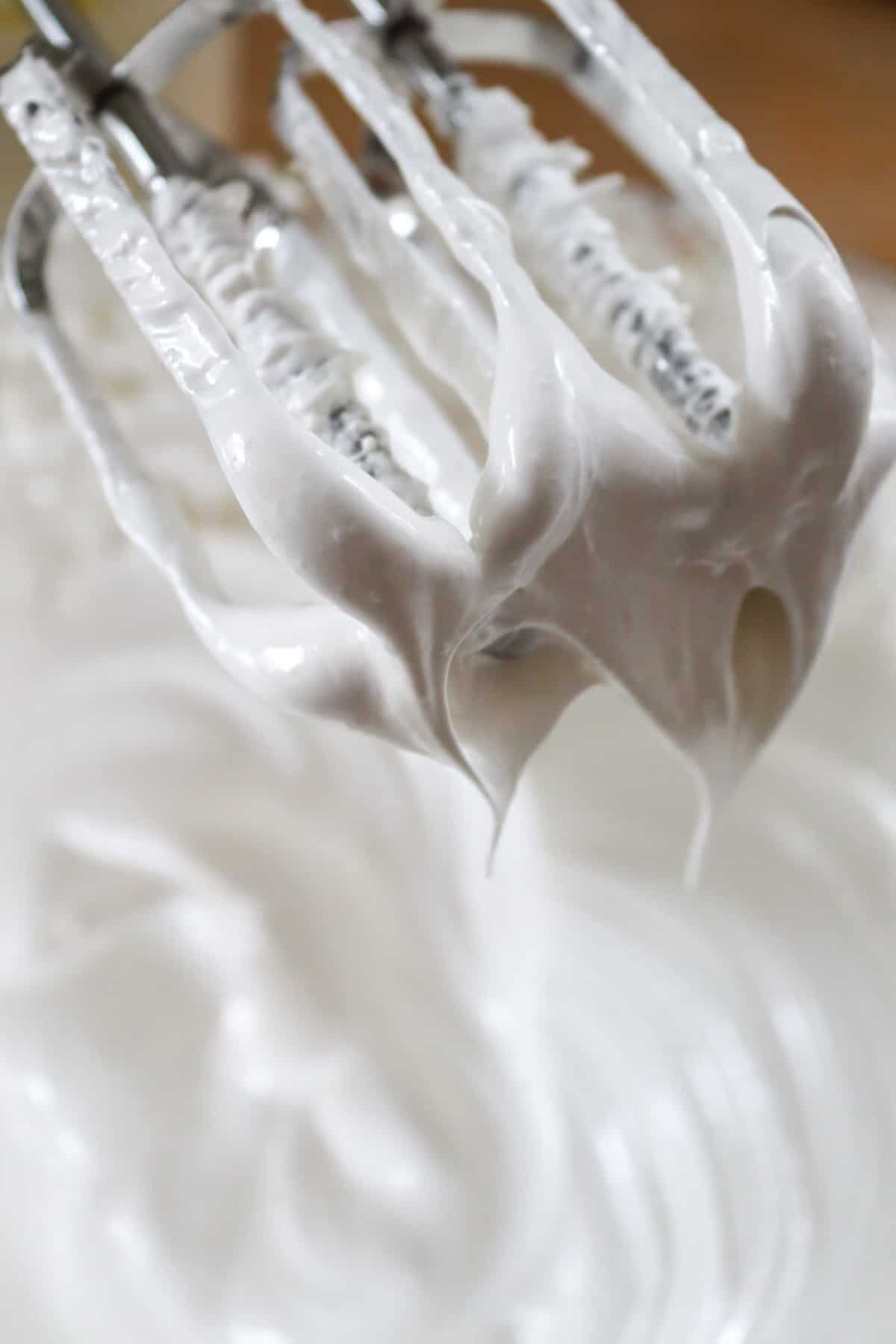
Macaronage
Mix the Italian meringue into the hazelnut paste in three stages.
Firmly mix in the first third of the Italian meringue with a metal or wooden spoon to loosen the paste. Fold in the remaining two-thirds one at a time using the softer spoon or spatula, being very gentle with the final third to not overmix the batter and make it too slack.
The test for the right consistency is to do a couple of figures of 8 with the large silicon spatula in the batter, which takes around 10 seconds to sink in and become reabsorbed. Any more, and it needs 2-3 more turns or mixes.

Pipe the macaron shells. Transfer the macaron batter to a large piping bag, relax it slightly with your hands, and then cut the tip off or use a round tip nozzle. Pip the macaron shells in circles onto a the cookie sheet, leaving a 2cm gap in between each macaron.
Pick up the tray and firmly smack it down onto a work surface twice to settle the Italian macaron batter and help pop remaining air bubbles.
Baking hazelnut coffee macarons
Bake the hazelnut coffee macarons in the preheated oven straight away for 17 minutes, then remove them from the oven and allow them to cool on the tray; then you can transfer to a wire rack if needed.
Filling macarons
Make the macaron filling. Stir a tablespoon of water into the ground coffee and then whisk it into the cream with the cinnamon until it thickens.
Put the coffee cream filling into a piping bag, cut a small piping tip, and pipe filling onto half the hazelnut coffee macaron shells before sandwiching together with the others.
Hint: macarons taste best when they have had a little time to absorb some of the moisture from the filling and go slightly chewy, 2-4 hours after filling.
Top tip
I personally do not add extra sugar to the coffee cream filling, which will mean it does taste slightly bitter on its own. However, once sandwiched between two sweet hazelnut macaron shells, the flavor is perfectly balanced. If you have a very sweet tooth, you could add some sifted icing sugar to the filling.
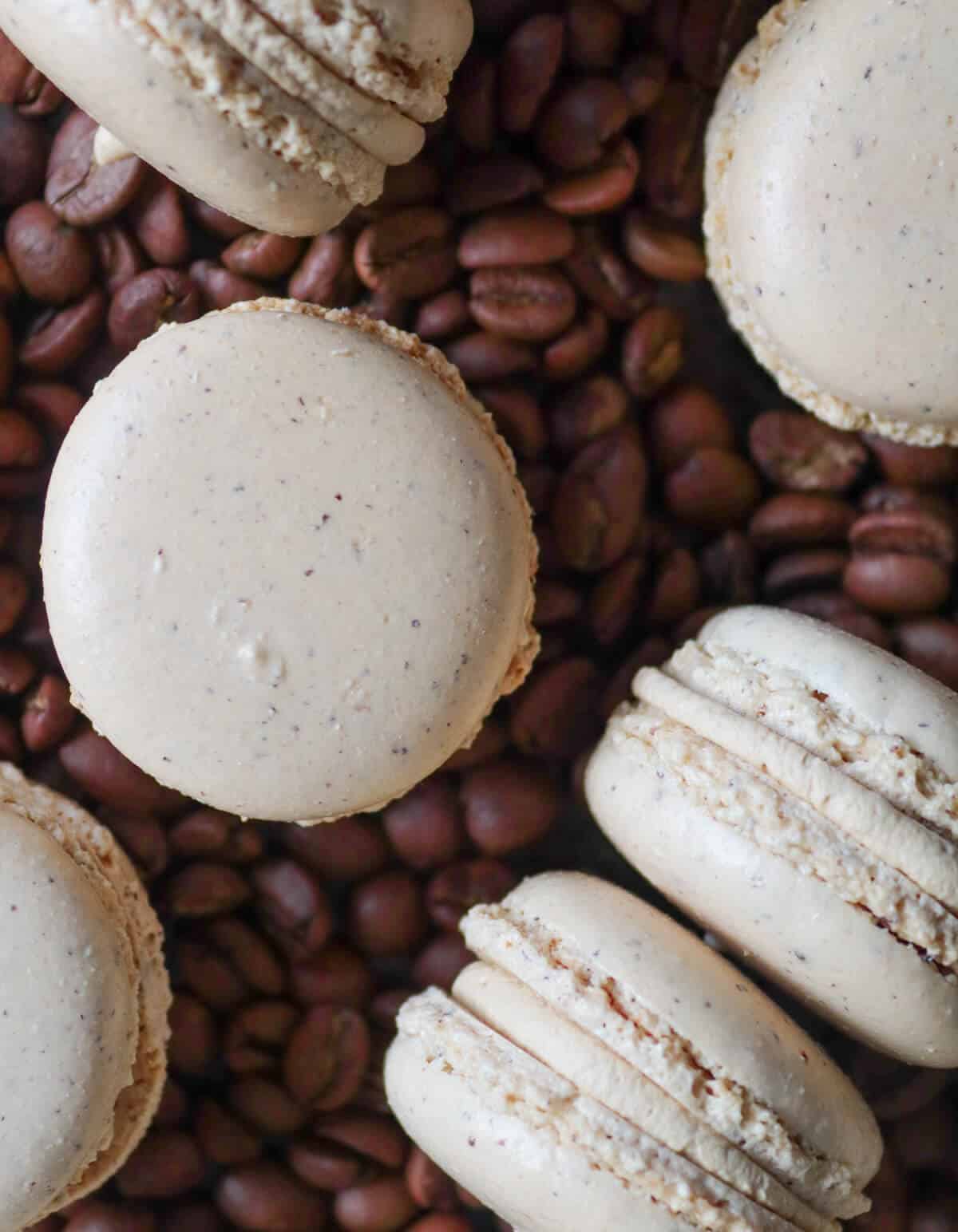
Wine pairing
Try a sweet Madeira with these hazelnut coffee macarons. This fortified Portuguese wine will pair beautifully with both the coffee and toasted hazelnut flavors. If you love sweet coffee recipes, try these coffee cupcakes as another delicious baked snack.
Variations
Try some of my other macaron recipes!
- Spiced pumpkin cheesecake macarons
- Fig and Cardamom macarons
- Blueberry cheesecake macarons
- Mango macarons
- Chocolate cinnamon macarons
- Festive savoury macarons with goat cheese and cranberry
Equipment
- Weighing scales. Digital is best. Baking is a science, after all, so we need precision! I do not recommend using the cup system to make macarons.
- A sieve to ensure that the powdered sugar and almond flour is as fine as possible.
- A blender/food processor to thoroughly combine the almond flour and powdered sugar. This ensures a completely smooth finish on your macaron shells.
- A small saucepan to make your sugar syrup
- A jam or sugar thermometer to measure the temperature of the hot sugar syrup. The sugar syrup needs to be at a particular temperature to make Italian meringue, and it is impossible to judge without a thermometer. The best thermometers for sugar syrup do not allow the bulb to touch the bottom or sides of the saucepan, thus ensuring you are measuring the temperature of the sugar and not the pan.
- An electric whisk or stand mixer to whisk your room-temperature egg whites into soft peaks before slowly adding the hot sugar syrup.
- Two large mixing bowls, preferably glass. Try to avoid using a metal mixing bowl for the Italian meringue, as it will conduct heat and prevent the mixture from cooling.
- A metal mixing spoon for combining ingredients more vigorously.
- A silicon mixing spoon or spatula for further, more gentle mixing.
- Baking sheets/trays - not high-sided ones, as this builds up too much steam
- Silicon mat or baking parchment paper (but the silicon mats are better and allow for lower waste as they are not single-use)
- Piping bags - to pipe your macarons onto a baking tray and then also to pipe your fillings.
Storage
Store leftover macarons in the fridge due to their cream filling and use them within 3-4 days. They will soften over time, so are best enjoyed fresh.
You can freeze macaron shells before filling them and use them within 1 month.
FAQ
Hazelnut flour is less dense than almond flour, and this is why we use a mixture of the two. I find using a mixture of almond and hazelnut flour makes the best macarons.
Technically yes, but the issue can be the fat content, and this needs to be carefully calculated. Nuts are naturally oily, and the fat-to-sugar balance needs to be right in macaron recipes.
If you want to make colored macarons, add powdered food coloring to the nut flour and powdered/confectioners' sugar before making the nut paste. Do not use liquid food coloring. It will unbalance the macaron mixture.
French meringue and Italian meringue are both made with sugar and egg whites. But French meringue is made by whisking egg whites and then adding granulated sugar, whereas Italian meringue is made by adding hot sugar syrup to the egg whites. This means that Italian meringue is technically cooked.
Other macaron recipes to try
📖 Recipe

Hazelnut Coffee Macarons
Equipment
- 1 Sieve Blender/food processor
- 1 Metal or wooden mixing spoon
- 3 Silicon baking mat or baking parchment paper
Ingredients
Almond paste
- 185 grams (6.5 oz) Powdered sugar (icing sugar or confectioners sugar)
- 93 grams (3.3 oz) Ground almonds
- 93 (3.3 oz) Ground hazelnuts
- 65 grams (2.3 oz) Egg whites
- 1 teaspoon Ground instant coffee /espresso powder
Italian meringue
- 185 grams (6.5 oz) Granulated sugar
- 100 ml (4 floz) Water
- 65 grams (2.3 oz) Egg whites
Coffee cream filling
- 500 ml (17 floz) Double cream /heavy cream
- 2 tablespoon Ground instant coffee /espresso powder
- 1 tablespoon water
- 1 teaspoon Ground cinnamon
Instructions
- Preheat the oven to 145 degrees Celsius / 295 Fahrenheit.
- Make the nut paste by sieving the almond and hazelnut flours and icing sugar to remove any lumps. Then blend them all together until they are a very fine consistency and thoroughly combined. Stir in the coffee powder and put the mixture into a large mixing bowl.
- Mix the first lot of egg white with the ground nuts/powdered sugar mixture until it is fully incorporated.
- Prepare the Italian meringue. Place the water and granulated sugar into a saucepan. Gently warm the water and stir to dissolve the sugar. Turn up the heat, stop stirring and place the sugar thermometer into the mixture.
- Once the temperature reaches 115 degrees Celsius/240 degrees, whisk the other egg whites in a separate large bowl until they form soft peaks. Then slowly start to pour the sugar syrup into the eggs, whilst continuing to whisk.
- The Italian meringue will turn a smooth, glossy and opaque white. Continue to whisk once all of the sugar syrup has been added to bring down the heat until you can touch the side of the bowl and it feels warm but not hot.
- Mix the Italian meringue into the nut paste in three stages. Firmly mix in the first third of the Italian meringue with a metal or wooden spoon to loosen the paste. Fold in the remaining two-thirds one at a time using the softer spoon or spatula, being very gentle with the final third to not overmix the batter and make it too slack.
- Pipe the macaron shells. Transfer the macaron batter to a piping bag, relax it slightly with your hands and then cut the tip off. Pip the macaron shells onto a lined baking tray, leaving a 2cm gap in between each macaron.
- Pick up the tray and firmly smack it down onto a work surface twice to settle the Italian macaron batter and help prevent air bubbles.
- Bake the hazelnut coffee macarons straight away for 17 minutes, then remove them from the oven and allow them to cool on the tray.
- Make the macaron filling. Stir a tablespoon of water into the ground coffee and then whisk it into the cream with the cinnamon until it thickens.
- Put the coffee cream filling into a piping bag and pipe it onto half the hazelnut coffee macaron shells before sandwiching together with the others.
Video
Nutrition
Food safety
- Do not leave boiling sugar unattended and keep away from animals and children.
- Wash hands and utensils after handling raw eggs.



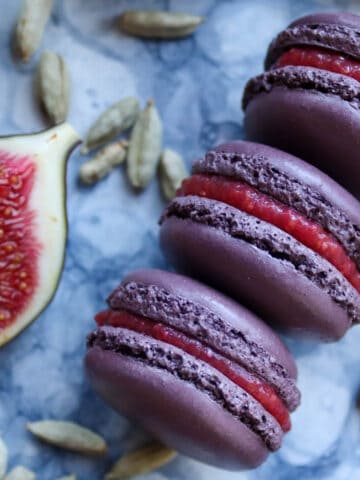



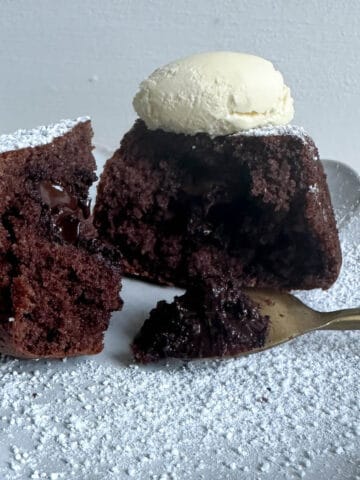

Beth says
Wow these were so tasty! The hazelnut shells against the strong coffee filling was amazing